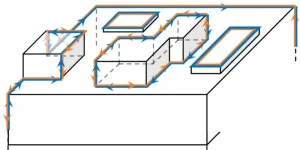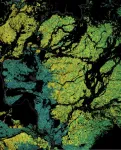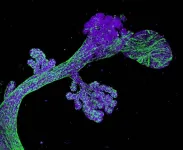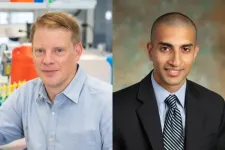(Press-News.org) Just like a book can’t be judged by its cover, a material can’t always be judged by its surface. But, for an elusive conjectured class of materials, physicists have now shown that the surface previously thought to be “featureless” holds an unmistakable signature that could lead to the first definitive observation.
Higher-order topological insulators, or HOTIs, have attracted attention for their ability to conduct electricity along one-dimensional lines on their surfaces, but this property is quite difficult to experimentally distinguish from other effects. By instead studying the interiors of these materials from a different perspective, a team of physicists has identified a surface signature that is unique to HOTIs that can determine how light reflects from their surfaces. As the team reports in the journal Nature Communications, this property could be used to experimentally confirm the existence of such topological states in real materials.
“The bulk or interior properties of HOTIs and other topological insulators have been discounted for a long time, but it turns out that a lot of interesting things are going on there as well,” said Barry Bradlyn, a physics professor at the University of Illinois Urbana-Champaign and a project co-lead. “When we looked at the surfaces through a more careful lens, they immediately stood out as far from trivial or featureless.”
For a long time, topological insulators have been noted for their ability to carry electrical currents on their surfaces while having insulating interiors. HOTIs, though, would restrict electrical conduction to a one-dimensional edge, or “hinge,” rather than the entire two-dimensional surface.
“Charles Kane, who discovered topological insulators, introduced a good analogy,” said Benjamin Wieder, a faculty member at the Institut de Physique Théorique, Université Paris-Saclay and project co-lead. “We can think of standard topological insulators as Hershey’s Kisses™. A conducting metal foil wrapped around an insulator that doesn’t conduct electricity, the chocolate in this case, is a pretty good way to understand them. With HOTIs, though, it’s as though someone took the foil and crumpled it into a thin ring encircling the chocolate.”
While surface conducting states have been observed in standard topological insulators, resolving the hinge in HOTIs has proven to be exceptionally difficult. Bradlyn explained that this property can only exist in material samples that have an unusually high degree of symmetry, meaning that their crystal structures must be unrealistically perfect.
Instead, Bradlyn and his collaborators turned their attention from the hinge state to the interior, where the electrons tend to “delocalize” from individual atoms and spread through the entire material. Unlike past studies that treat all electrons the same, the researchers considered differences in spin – a property of electrons that allows them to behave as miniature magnets.
“When we divided the interior electrons into their two possible spin states, up and down, we saw that each state leaves a unique surface signature,” said Kuan-Sen Lin, a physics graduate student at the U. of I. and the study’s lead author. “Even though the surface of a HOTI seems uninteresting, when you look at what each spin is separately doing on the surface, an unmistakable new behavior emerges that we hope will soon be measured in experiment.”
Because electrons with different spins behave as magnets, they respond differently when electric voltage is applied to the material, causing the two spin states to accumulate on opposite sides. This accumulation can be detected by taking advantage of the magneto-optic Kerr effect, in which the polarization, or orientation of the light, changes when it reflects from the surface of a magnet. In the case of HOTIs, the researchers calculated the polarization change from each spin state, and they found it to be exactly half the change that would result from an ordinary insulator.
“In the Kiss analogy, we might expect that, because the foil has been crumpled, the chocolate is in direct contact with the air,” said Gregory Fiete, a physics professor at Northeastern University and a corresponding author on the study. “With the spin-dependent surface behaviors we found, we can say that there is in fact a transparent layer that keeps the chocolate separate from the rest of the supermarket.”
By building on first-principles calculations with the specialized theoretical toolkit the researchers developed for this study, they identified the metal bismuth bromide as a very strong candidate for observing this effect. They are currently working with U. of I. physics professor Fahad Mahmood and U. of I. materials science & engineering professor Daniel Shoemaker to design and perform the experiments proposed in this study.
“The properties of HOTIs that we identified here would be very useful in quantum computing and spintronic devices, but we need to see them in experiment first,” Bradlyn said. Wieder added, “We hope that our work shows that the insides and surfaces of topological materials still host many mysterious and advantageous features if you know how to look for them.”
The article, “Spin-Resolved Topology and Partial Axion Angles in Three-Dimensional Insulators,” is available online. DOI: 10.1038/s41467-024-44762-w
The first principles calculations on bismuth bromide were performed by Zhaopeng Guo and Zhijun Wang of the Chinese Academy of Sciences
Additional computational support was provided by Jeremey Blackburn of Binghamton University.
Giandomenico Palumbo of the Dublin Institute for Advanced Studies and Yoonseok Hwang of the U. of I. also contributed to this work.
Support was provided by the Center for Quantum Sensing and Quantum Materials, an Energy Frontier Research Center of the U.S. Department of Energy, Office of Science, Basic Energy Sciences; the European Union and European Research Council’s Horizon Europe Research and Innovation Program; the National Science Foundation; the Alfred P. Sloan Foundation; the Air Force Office of Scientific Research; the Office of Naval Research; the National Natural Science Foundation of China; and the Strategic Priority Research Program of the Chinese Academy of Sciences.
END
The surface knows what lies beneath: physicists show how to detect higher-order topological insulators
2024-01-16
ELSE PRESS RELEASES FROM THIS DATE:
Dr. Marcus D. Goncalves inducted into the American Society for Clinical Investigation
2024-01-16
Dr. Marcus D. Goncalves Inducted into the American Society for Clinical Investigation
Dr. Marcus D. Goncalves, the Ralph L. Nachman, M.D. Research Scholar and an assistant professor of medicine in the Division of Endocrinology, Diabetes and Metabolism at Weill Cornell Medicine, has been elected as a member of the American Society for Clinical Investigation (ASCI) for 2024.
The ASCI is one of the nation’s oldest nonprofit medical honor societies and focuses on the unique role of physician-scientists in research, clinical care and medical education. It is comprised of more than 3,000 physician-scientists representing ...
Method improves detection of potential therapeutic tumor targets in human biopsies
2024-01-16
Many cancers, including some types of breast cancer, are driven by alterations in the activity of cellular enzymes called kinases. Therapies that directly inhibit these cancer-promoting activities have proven to be effective for patients in which individual driving kinases can be diagnosed.
One major challenge to this therapeutic approach is to accurately quantify tumor kinases in human biopsy samples. Many kinases are not abundantly present and are therefore more difficult to measure accurately. Although currently there are methods to quantify small amounts of kinases, measuring multiple kinases ...
Canadian Science Publishing goes live on OA switchboard
2024-01-16
As part of our open science strategy, Canadian Science Publishing (CSP) is pleased to announce our new partnership with OA Switchboard, a mission-driven, community led initiative designed to simplify the sharing of information between stakeholders about open access publications throughout the whole publication journey.
“We’re thrilled to partner with the OA Switchboard to improve the visibility of the work we publish,” says Elaine Stott, Chief Executive Officer of CSP. “This initiative enables institutions, consortia and funders to report ...
A new, rigorous assessment of OpenET accuracy for supporting satellite-based water management
2024-01-16
Sustainable water management is an increasing concern in arid regions around the world, and scientists and regulators are turning to remote sensing tools like OpenET to help track and manage water resources. OpenET uses publicly available data produced by NASA and USGS Landsat and other satellite systems to calculate evapotranspiration (ET), or the amount of water lost to the atmosphere through soil evaporation and plant transpiration, at the level of individual fields. This tool has the potential to revolutionize water management, allowing for field-scale ...
Multisite clinical trial will compare three FDA-approved drugs for Rett syndrome treatment
2024-01-16
Vanderbilt University Medical Center received a $13 million Department of Defense grant to lead a multisite clinical trial that will evaluate repurposed FDA-approved drugs as treatment options for patients with Rett syndrome.
Affecting 1 in 10,000 females at birth, and males even more rarely, Rett syndrome is a rare genetic neurodevelopmental disorder that affects brain development.
“It robs affected individuals of the ability to use their hands or speak and causes problems with mobility, as well as a number of other issues,” said Jeffrey Neul, Annette Schaffer Eskind Professor, ...
St. Jude Home Care, LLC is first US pediatric home health agency to earn new category of industry certification
2024-01-16
St. Jude Children’s Research Hospital announces today that St. Jude Home Care LLC, a home health agency for the hospital’s patients, earned dual certifications in both pediatrics and home health from Community Health Accreditation Partners (CHAP), an independent, non-profit, accrediting body for home and community-based healthcare organizations. St. Jude Home Care LLC is the nation’s first agency to achieve that distinction. CHAP is the only organization in the U.S. that grants a discrete pediatric certification ...
Study pinpoints breast cancer ‘cells-of-origin’ in high-risk women
2024-01-16
Australian scientists have pinpointed likely ‘cells-of-origin’, the source cells that can grow into breast cancer, in women carrying a faulty BRCA2 gene who are at high risk of developing the disease.
The WEHI-led study also showed these cells have potential to be targeted with an existing cancer drug to delay tumour growth, in findings that may lead to future preventive treatments for the disease.
At a glance
Women with faulty BRCA2 genes are at a substantially higher risk of developing breast ...
Supports help keep Aussie firefighters safe
2024-01-16
House fires, road crashes and emergency rescues – they’re all part of the job for Aussie firefighters. And in such physically demanding roles, maintaining a high level of fitness and movement quality is essential.
Now, new research from health and fitness experts at the University of South Australia shows that professional firefighters have reduced movement quality as they age, which could put them at greater risk of injury.
Conducted by UniSA masters researcher, Alex Redshaw, in partnership with the South Australian Metropolitan Fire Service (MFS), the findings indicate that firefighters over the age of 50 generally have lower movement ...
Study: New deepfake detector designed to be less biased
2024-01-16
BUFFALO, N.Y. — The image spoke for itself.
University at Buffalo computer scientist and deepfake expert Siwei Lyu created a photo collage out of the hundreds of faces that his detection algorithms had incorrectly classified as fake — and the new composition clearly had a predominantly darker skin tone.
“A detection algorithm’s accuracy should be statistically independent from factors like race,” Lyu says, “but obviously many existing algorithms, including our own, inherit a bias.”
Lyu, PhD, co-director of the UB Center for Information Integrity, and his team have now developed what they believe are the ...
Researchers find that using patients’ own blood, rather than saline, helps preserve veins in coronary bypass grafts
2024-01-16
In a collaboration between the Fralin Biomedical Research Institute at VTC and Carilion Clinic, researchers learned that by preserving large superficial leg veins intended for coronary bypass grafting in a mixture of the anticoagulant heparin and blood, rather than heparin and saline, the veins were better protected from cell and tissue damage.
Their findings, published in January in the Journal of Vascular Research, could inform surgical practices and enhance the long-term success of vein grafts in coronary bypass surgeries.
“Ultimately, we're putting healthier blood vessels ...





